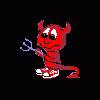Search the Community
Showing results for tags 'Concluding the INDIGENE serie'.
-
THE LIAM JURRAH STORY by Grapeviney It's the middle of 2009 and the struggling Demons are slated to play the Bombers at their Docklands lair. Melbourne are in an almighty funk; they will win just four matches for the season and will go on to take the wooden spoon that year. But into the midst of this bleakest of periods bursts a beacon of brilliance in the form of Liam Jurrah, a fully initiated Aboriginal from Yuendemu in the Tatami Desert who will become known as the 'Walpiri Warrior', or more simply, 'Jurrahcane'. It took Jurrah barely a minute to electrify the crowd in his debut against the Dons that day, scoring a point after dashing towards goal from half-forward just moments after coming on to the ground from the bench. In the next quarter he registered his first major, flying high for the ball in the goalsquare, outpointing two Essendon defenders and somehow grabbing the ball on the goal-line to slot it through as he lay prostate on the turf. Football had a freakish new talent in its ranks who seemed capable of anything and everything. As Bruce Hearn Mackinnon – who lurks on this forum as 'Rudeboy' - notes in his book The Liam Jurrah Story: From Yuendemu to the MCG, Jurrah's electrifying play quickly captured the imagination of the football world – respected commentator Brian Taylor said not long after Jurrah's exciting debut that “if he got wind that any of the coaches at Melbourne were starting to fill Liam's head with talk about structures and team rules, he'd head down there and personally berate them”. Fast forward two-and-a-half years and the Demons are well into their pre-season training for the 2012 year, under a new coach who has explicitly stated that he wants his charges to be regarded as the league's toughest team to oppose. Against this backdrop, a question mark hangs over Jurrah's head, if not among the vast array of new coaches at Melbourne then certainly among some of its supporters, who bemoaned his lack of defensive pressure in the season just passed, one which saw most successful clubs employ some form of forward press to keep the ball locked in their front half of the ground. How will Jurrah respond to the new regime at Melbourne? Is there room these days for a player who flies in the face of orthodoxy and bends the rules to suit his magical innate abilities? Time will tell, although some who criticise Jurrah's seeming unwillingness to chase his opponents have forgotten just how threateningly he did do that in the early part of his career. Regardless of what happens in the future, this book will stand out as one of the more unusual in the annals of football literature, if only for the fact that its subject had played barely two-dozen games at the highest level when it was released in the middle part of last year. Perhaps even more strange is the fact that its author, who writes with obvious affection for his charge, is not a native Demon, but rather a committed Collingwood man who, along with a group of friends and colleagues named the 'Industrial Magpies', first tried to land Jurrah down at Melbourne's old arch rivals. And therein lies the essence of this book, which tracks Jurrah's journey from the remotest parts of Australia to the spiritual home of its favourite sport, the Melbourne Cricket Ground. It's not a book of premierships and legends, like the biography of Norm Smith, nor is it one of heartache and single-handed heroism, as is the autobiography of Robbie Flower, but rather a tale of how one man came to defy the odds and merely make it to the starting line of an AFL career. That Jurrah is even on the cusp of what could be an exhilarating football career is due in large part to the efforts of the author, his family, and a small group of friends, who have never lost faith in their man and who have helped him over numerous hurdles along the way, all of which are recounted in this book. If there is one obvious omission, it is the lack of detail about what it actually means to be an “initiated” man in Walpiri culture, which would add a fascinating layer of insight into what the reader gleams about Liam Jurrah the person. As the author briefly explains, this is 'secret men's business' and cannot be imparted to the outside world. But anyone who thinks this book is but a shallow description of a man who is yet to really make his mark on the game is mistaken. Sure, the story may be simple and the writing straightforward, but in its pages we learn a lot about Liam, and get a brief glimpse into the fascinating culture of indigenous Australia. There are interesting anecdotes about family, community and friendship, insights into death and loss, and more than enough snippets about Jurrah's relationships with his team-mates – particularly his indigenous and Tiwi Island 'brothers' at the club - to carry the day and make this a worthwhile read. Demon fans will be hoping that there will be a second edition of this book to be published many years down the track, one which tells not only of Jurrah's journey from the red centre to the centre of the football world, but also recounts the story of how he came to kick hundreds of goals for the red and blue and helped propel the club to the ultimate success which has eluded it for so long. The Liam Jurrah Story Price: $22.99 at all good booksellers.

